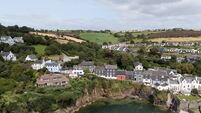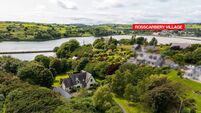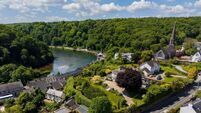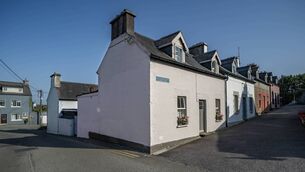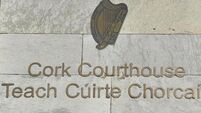Cool house under the mountain

LATE spring 10 years ago, I swerved onto the little byroad leading up the mysterious, Coolkelure House. The long laneway ended abruptly at a small turning directly in front of the house, most of which was covered in a tangle of overgrown bushes that surrounded each side of the striking mansion.
A Hammer horror set-piece in the middle of the Irish countryside, this was not only an anachronism — it was downright weird. We don’t do neo-Gothic much in Ireland, (in houses, anyway) but this was plonked in a hidden valley in West Cork. Coolkelure was a strange one. I later discovered it had been designed by Hill and Co — a firm founded by the father of Ballymaloe’s Myrtle Allen, and was built in 1870. It was an early harbinger of Gothic Revival in Ireland, which, domestically at least, withered on the vine.
Once inside, the abandoned and parlous state of the property added to the list of questions, for which the auctioneer on that occasion had no answers. But that’s often the case for agents operating in a situation where generational memories mean that should they blab or give out information, however general, the indiscretion is remembered long after the slip is forgotten. So black sheep and bad blood are never mentioned to the blow-ins and blow-backs. If you don’t find out for yourself, so the thinking goes, you haven’t done your homework; ergo, more fool you.
I never did find out how and why the house was built. Was there an ambitious and romantically-inclined chatelaine involved? Or was it just the desire to show off and be different in a region where the Georgian vernacular never lost its grip? And maybe it was all a bit Wuthering Heights, dark passions played out under Coolemountain?
Nothing so fanciful, I imagine, rather the more prosaic but still appalling fact that Coolkelure was burnt out in the Troubles, and while renovated and replumbed afterwards, perhaps it was never the same again, nor engendered the same attachment.
Whatever the reason, Coolkelure was derelict for quite a while and for such a relatively young house too — one on which a lot of care and money had been lavished: The handcarved limestone mullions, for instance, the gargoyles, the intricate barges and the sheer scale of the six bedroomed house; up with the best of the McMansions of the Celtic Tiger era, at over 4,500ft sq, and including a ballroom.
The house was surrounded by a number of ancillary buildings, coach houses, underground meat lockers, food safes, staff quarters, and coach houses, along with byres and barns.
True to form for an estate of this type, (probably part of the Earl of Bandon’s holdings), it had a mini-me gate lodge, which was sold off prior to the disposal of the main house and which featured on these pages a couple of times.
Back in 2002 when Coolkelure House went on the market, property was on the rise but had not reached the point of dangerous acceleration that occurred by 2005/6 but it nevertheless carried a substantial asking price, close on £500,000 which didn’t include a bank of 45 acres to the north of the house, part of its original demesne.
Uninhabitable in its condition then, it took a while to sell — not a lot of people were prepared to overlook the work involved to get to the final result. Save for two undaunted, DIYers from the UK who came in search of a little holiday home and left with a crumbling estate.
They weren’t bright-eyed ingenues either — Phillipa and Adrian Rother were a pair of seasoned property renovators not completely blind to the extent of the challenge involved, but a pair whose ambition to restore the house saw them purchase the property after some hard negotiation. They bought the land too because it was ridiculous to have a house of that stature without some land around it, Adrian says today.
While they won’t get a return on that investment now, with current low values, the couple have come to the end of 10 hard years of unstinting renovation and are selling up to move back home permanently. They’ve never used the house as a full-time home — rather have snatched weeks and months at a time to put in the effort of re-building. While Adrian is the sort of Renaissance man who can turn his hand to any skill, he credits his wife with the vision, drive, and purity of purpose in the renovation.
And it’s a bit of a pity now that all of the hard work is done that they’re moving out. But you imagine they had other plans at one stage and now time and life have wrought changes and they are heading in a different direction. The house, of course, remains but this time it’s renewed, revived, and awaiting that final finish to make it the home it should be. It needs a family, an extended tribe, perhaps, or a purpose to make use of all that space and all the volume in height, width, and breadth that it offers.
This is an ideal retreat house, a sanctuary, a Tyrone Guthrie centre in the making, or even a locus for a religious community — after all, the alternative community at Coolemountain is just down the road and the location is remote, but accessible.
Coolkelure House is close to Dunmanway, but miles away in terms of seclusion. It offers six bedrooms and six bathrooms as well as a range of living rooms, including the impressive ballroom with its huge bay windows and 12’ high ceilings on 45 potentially self-sufficient acres. The scale of the work won’t be appreciated on first glance; this is a house that has gobbled up the effort. It’s so vast and feels much bigger than a simple measurement conveys. Neither is it predictable, built for a time of servants, it has a warren of little rooms and unsustainably grand rooms, like the ballroom. This really needs to be filled — and was one of the worst rooms in the house when the Rothers began their project.
According to Adrian, it was rebuilt from the base up, with new struts, floorboards, skirting, and architrave, as well as damp proofing. Adrian has a large joinery in one of the farm’s sheds so a lot of the new timbers were cut to size on site, and all of the replacement windows, joinery, and window-shutters were hand-made by him. So is it any wonder the work took 10 years on a part-time basis?
Walls are lime plastered and finished in lime putty, and flooring is planed red deal to match the fine, revival style staircase. The roof has been repaired and all of the lead work is redone — even the decorative down pipes are brazed lead reproductions, created by Adrian to match the original — close to the medieval-style door with its heavy iron studding and massive original lock.
The Rothers made one simple addition and again, it’s sensitive and hand-made: they added a glass conservatory/orangery, to Phillipa’s design, on the south side of the house, leading out from one of the smaller sitting rooms. Again, all of the work was completed on site and it’s a sun trap looking out onto the rolling hills of this part of Dunmanway. A similar porch is created at the rear, where it leads out to a west-facing kitchen garden — one of the house’s prettier sides. The main façade is stern and masculine, this side is softer and informal.
But for all that, Coolkelure is a family house and built as such — there’s isn’t an imposing hallway, rather a sub-baronial room running across the house with main rooms at each side and servants’ area at the rear. Those former quarters still retain the old terracotta tiling, and the sense of time is continued with a four-oven Aga and old pitch pine timber reconfigured into country kitchen units in the main kitchen, with similar in a nearby utility.
Outhouses are roofed and dry, ready to go on to become new quarters for visitors, postulants, guests, or holiday homes, and very pretty they will be too, if the work so far is anything to go by. There’s also a walled garden and a flank of some mixed quality paddock, some of which is, quite frankly, a bit heavy and low lying. But these rushy fields are all to the good for those who want an older form of husbandry, a place where nothing is forced or foreign, a redoubt to keep the busy world at bay.
John Hodnett of Hodnett Forde is selling Coolkelure House and is seeking offers in the region of 750,000 for the intriguing West Cork property.
Location: Dunmanway, Co Cork
Price: €750,000
Size: 418sq m ( 4,500 sq ft)
Bedrooms: 3
BER rating: Exempt
Best feature: Splendid structure
VERDICT: This is a true one-off in a location just minutes from Coolkelure Lake, overlooked by Noan Hill and set amidst the drumlins of Dunmanway








